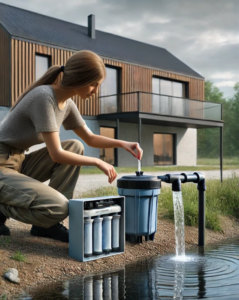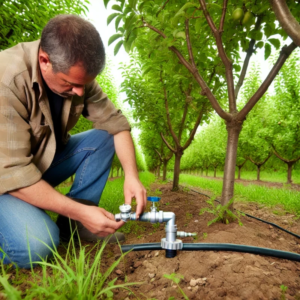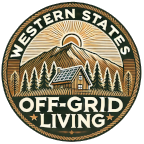“The off-grid house uses the sun, the soil, and the water. Photo Credit: iStock. A
Category: Off-Grid Water
Off-Grid Water: Ensuring a Reliable Supply for Your Homestead
When planning an off-grid lifestyle, securing a sustainable off-grid water supply system is essential. Unlike traditional homes that rely on municipal utilities, off-grid homesteaders must develop a water infrastructure that ensures access to clean and safe water for drinking, cooking, and sanitation. Here, we’ll explore various options and considerations for setting up an efficient off-grid water system.
Sourcing Your Off-Grid Water Supply System
 The first step in creating an off-grid water system is identifying a reliable water source. Depending on your location, common options include:
The first step in creating an off-grid water system is identifying a reliable water source. Depending on your location, common options include:
- Wells: Drilling a well provides a consistent supply of groundwater, but it requires a well pump to bring the water to the surface. The depth and flow rate of the well will determine the type of pump needed, and a backup system such as a manual pump or solar-powered option ensures availability during emergencies.
- Rainwater Harvesting: Collecting and storing rainwater in a water tank can supplement your water needs and reduce dependence on external sources. A properly designed system includes gutters, filters, first-flush diverters, and covered storage to prevent contamination and mosquito breeding.
- Surface Water: Rivers, ponds, and lakes can serve as a source but require robust filtration to ensure safety. Intake pipes should be positioned to minimize debris and sediment entry, and pre-treatment steps such as settling tanks or slow sand filters can enhance the efficiency of purification methods.
Off-Grid Water Pumps: Bringing Water to Your Home
A key component of any off-grid water supply system is an off-grid water pump. The right pump depends on the depth of your water source and your energy system. Options include:
- Solar-Powered Pumps: Ideal for those relying on renewable energy, these pumps run on solar panels and eliminate the need for fossil fuels. A direct-drive system works when the sun is shining, while a battery backup ensures functionality at night or on cloudy days.
- Hand Pumps: A reliable backup option in case of power failure. These can be simple lever-style pumps or deep-well models that use a piston mechanism to lift liquid from significant depths.
- Gravity-Fed Systems: If your source is located at a higher elevation, gravity can transport liquid without the need for an electric pump. This method works best when storage tanks are strategically placed to allow for sufficient pressure at fixtures.
Filtration for Safe Consumption
 Regardless of the source, purification is crucial for ensuring drinkable quality. Homesteads commonly use:
Regardless of the source, purification is crucial for ensuring drinkable quality. Homesteads commonly use:
- Ceramic or Carbon Filters: These remove sediments, bacteria, and some chemicals. Carbon models improve taste by reducing chlorine and other impurities, while ceramic units block larger pathogens and particulates.
- UV Purification: Kills bacteria and viruses using ultraviolet light. This method requires clear liquid for maximum effectiveness and is best used in conjunction with sediment filters.
- Reverse Osmosis: An effective method for removing contaminants but requires significant pressure. Waste liquid is a byproduct of this system, so careful planning is needed to maximize efficiency and minimize resource loss.
Storing Liquid for Daily Use
A reliable water tank is necessary for storing potable liquid and ensuring a steady supply during dry periods. Storage considerations include:
- Material: Food-grade plastic, metal, or concrete tanks prevent contamination. Each material has pros and cons, such as UV resistance, weight, and durability.
- Capacity: The size should be based on daily consumption and expected drought periods. Households with gardens or livestock may require larger storage than those relying solely on a well or small rain collection system.
- Placement: Elevated tanks can create a gravity-fed system, reducing the need for pumping. Underground cisterns provide insulation against temperature extremes and minimize evaporation losses.
Heating for Domestic Use
Heating liquid can be achieved through several methods:
- Solar Heaters: Passive or active solar heating systems provide an eco-friendly solution. Proper orientation and insulation improve efficiency, and batch models can store warm liquid for use after sunset.
- Wood Stoves with Heat Exchangers: Utilize excess heat from a wood stove to warm liquid. Copper coil heat exchangers can be installed in stove pipes or water jackets to efficiently transfer warmth.
- Propane or On-Demand Heaters: Effective for heating only when needed while conserving fuel. Tankless models provide consistent warmth without the standby losses of traditional storage heaters.
Managing Reuse for Sustainability
 Grey water, or used liquid from sinks, showers, and washing machines, can be repurposed to enhance sustainability. Proper grey water systems involve:
Grey water, or used liquid from sinks, showers, and washing machines, can be repurposed to enhance sustainability. Proper grey water systems involve:
- Filtering and Redirecting: Using natural filtration before directing liquid to gardens or orchards. Gravel beds, reed beds, or sand filters help remove contaminants and improve the quality for irrigation use.
- Legal Considerations: Some jurisdictions have regulations on reuse, so check local guidelines. Systems may need to meet specific requirements, such as subsurface irrigation or approved filtering mechanisms.
- Avoiding Contamination: Using biodegradable soaps ensures that reuse does not harm soil or plants. Proper routing ensures that excess nitrogen and phosphorus are absorbed by plant roots rather than contaminating groundwater.
Conclusion
Setting up a robust system requires careful planning, but with the right components—pumps, storage solutions, purification, and reuse management—you can achieve a reliable and sustainable supply. Whether you rely on a deep well, a rain-fed reservoir, or a combination of sources, ensuring access to clean liquid is a crucial step toward self-reliance in off-grid living.
Margaret Gallagher, 83, counts herself lucky as her Fermanagh cottage ‘with no nails at all’,
